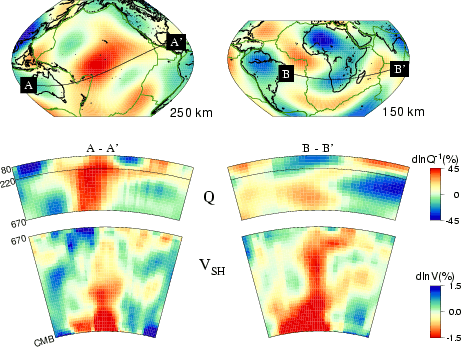
Three-dimensional
modeling of upper-mantle anelastic structure reveals that thermal upwellings
associated with the two superplumes, imaged by seismic elastic
tomography at the base of the mantle, persist through the upper-mantle
transition zone and are deflected horizontally beneath the lithosphere.
This explains the unique transverse shear wave isotropy in the
central Pacific. We infer that the two superplumes may play a
major and stable role in supplying heat and horizontal flow to
the low-viscosity asthenospheric channel, lubricating plate motions
and feeding hot spots. We suggest that more heat may be carried
through the core-mantle boundary than is accounted for by hot
spot fluxes alone. Science,
296, p513-516, 2002

Top panels: Map views of QRLW8 centered on the low
Q minima in the Pacific (left) and Africa (right). Bottom panels: Depth cross-sections
along profiles indicated in the top panels showing, Q distribution
in the upper mantle, and VSH distribution in the lower mantle. Note
the position of the low Q regions in the transition zone above the lowermost
mantle low velocity minima in all cases.
Press Coverage
. NBC
. Geotimes
. SF Chronicle
. News Bay
. Wirednews
. Cosmiverse
. Tampabay
. Azizona Daily Star